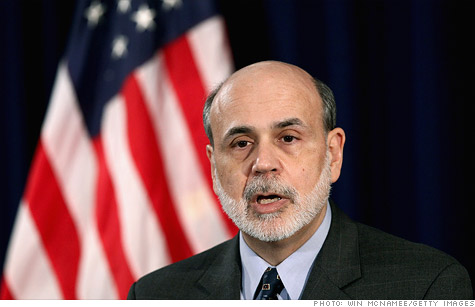Search News

NEW YORK (CNNMoney) -- In an effort to be more transparent with the public, the Federal Reserve gave more insight into its planning tools Wednesday than ever before.
For the first time in the Fed's history, the central bank released forecasts for the federal funds rate, its key tool for stimulating the economy, and released an explicit goal for the rate of inflation.
In addition, the Fed also released projections for inflation, economic growth and the unemployment rate, as it typically does four times a year.
So what does that all mean for the economy?
First the good news: Things would appear to be looking up for the job market. The central bank said it expects the unemployment rate to fall to between 8.2% and 8.5% in 2012, an improvement over what it had predicted back in November.
But the Fed is also predicting the economy will grow between 2.2% and 2.7% this year, slightly slower than it had previously thought.
"We continue to see headwinds emanating from Europe, coming from the slowing global economy and some other factors as well," Fed Chairman Ben Bernanke said in a press conference Wednesday afternoon.
Because economic growth remains sluggish, most of the policymakers at the Fed think the federal funds rate should remain near zero for the foreseeable future.
That said, they're deeply divided when it comes to the timing for a rate increase. The interest rate forecasts showed five of the Fed's 17 officials believe economic growth is slow enough to keep interest rates low until 2014. Six members thought rates should be hiked sooner than that, while another six believed low rates should remain in place until sometime after 2014.
Six of the 17 members expect the rate to be above 1% in 2014, while nearly all the members expect the fed funds rate to be around 4% in the long run.
Forecasting a low federal funds rate out to 2014 is thought to have a stimulative effect on the economy, by lowering interest rates on everything from mortgages to car and student loans.
But it's not set in stone. Bernanke said repeatedly that the Fed will continue to monitor economic data and adjust its forecasts accordingly. If the economy starts to improve more rapidly, the Fed could raise interest rates sooner than currently projected.
"People should realize that these forecasts are highly dependent on economic conditions," said Dean Croushore, an economics professor at the University of Richmond. "These are only good forecasts if the economy actually grows as slowly as the Fed thinks it will over the next two years."
Experts are also quick to point out that the Fed's forecasting record is far from stellar, and the wide range of internal viewpoints showed even at the central bank, uncertainty reigns.
"There's such a range of opinions," said Greg McBride, Bankrate.com's senior financial analyst. "Really putting those projections out there is going to do nothing more than reveal the human frailties of the Fed's forecasting abilities."
Bernanke even conceded that point Wednesday.
"Our ability to forecast three and four years out is obviously very limited. There's no question about that," he said.
Meanwhile, the central bank announced its new goal is to keep inflation around a 2% annual rate.
But this year, inflation is expected to remain below the new target, hovering between 1.5% and 1.8%.
If inflation remains low, the Fed could have some room to enact more stimulative policies, beyond the already $2.3 trillion in asset purchases it has made through two rounds of quantitative easing.
At the press conference, Bernanke essentially left the door open for QE3, remarking repeatedly that the Fed still has the ability to do more to bring the unemployment rate down.
"If the situation continues with inflation below target and unemployment declining at a rate which is very, very slow, then... the logic of our framework says we should be looking for ways to do more," Bernanke said.
The Fed's press conferences, which started last year, and the new forecasts are all part of Bernanke's goal to make the Fed more transparent.
"The Committee seeks to explain its monetary policy decisions to the public as clearly as possible," he said, reading from a statement. "Such clarity facilitates well-informed decision making by households and businesses, reduces economic and financial uncertainty, increases the effectiveness of monetary policy, and enhances transparency and accountability, which are essential in a democratic society." ![]()
| Overnight Avg Rate | Latest | Change | Last Week |
|---|---|---|---|
| 30 yr fixed | 3.80% | 3.88% | |
| 15 yr fixed | 3.20% | 3.23% | |
| 5/1 ARM | 3.84% | 3.88% | |
| 30 yr refi | 3.82% | 3.93% | |
| 15 yr refi | 3.20% | 3.23% |
Today's featured rates:
| Latest Report | Next Update |
|---|---|
| Home prices | Aug 28 |
| Consumer confidence | Aug 28 |
| GDP | Aug 29 |
| Manufacturing (ISM) | Sept 4 |
| Jobs | Sept 7 |
| Inflation (CPI) | Sept 14 |
| Retail sales | Sept 14 |